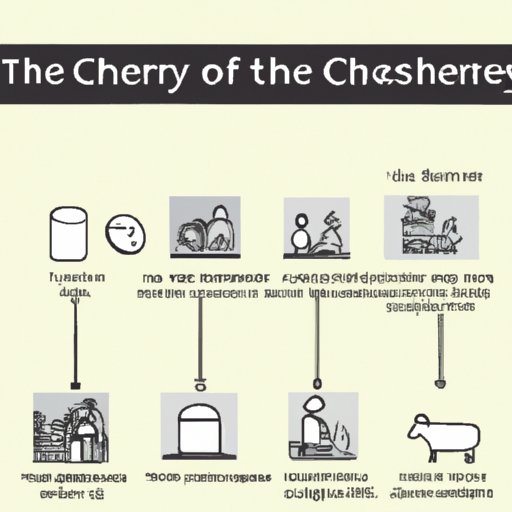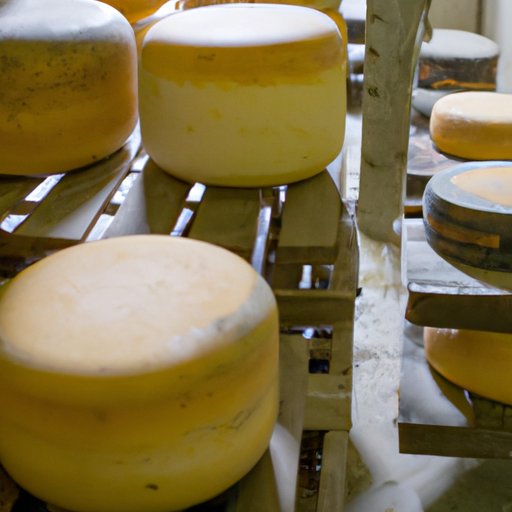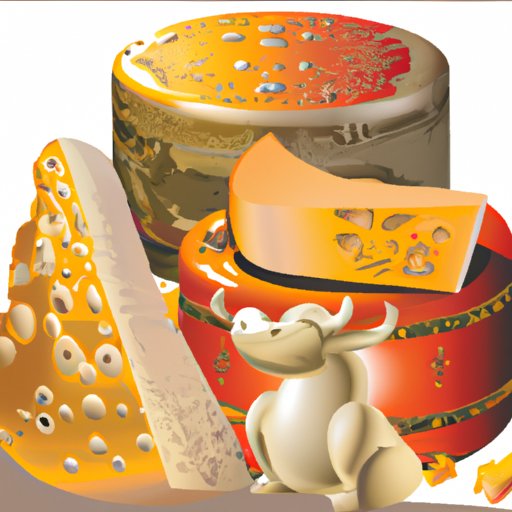Introduction
Cheese is one of the oldest known foods, with records of its production dating back thousands of years. While it’s impossible to pinpoint exactly when cheese was invented, there are a few theories that help us understand how it came to be. In this article, we will explore the history of cheese, from its invention in ancient Egypt to its modern-day production around the world.

Historical Timeline of Cheese Invention
The earliest evidence of cheese production dates back to 7000 BCE in what is now Poland. However, it wasn’t until much later that cheese became a widely consumed food. Here is a timeline of some of the major milestones in the history of cheese:
Ancient Egypt
The first written record of cheese comes from ancient Egypt around 2000 BCE. According to Herodotus, an ancient Greek historian, the Egyptians were making a type of cheese from sheep or goat’s milk. This cheese was likely similar to feta or ricotta, which are still popular today.
Ancient Greece
By 500 BCE, cheese had become an important part of the diet in Ancient Greece. The Greeks used it in religious rituals, and it was thought to have medicinal properties. They also developed a method for pressing cheese curds into blocks, which allowed them to store and transport it more easily.
Europe in the Middle Ages
Cheese production continued to spread across Europe during the Middle Ages. Monks began making cheese in monasteries, and it became a staple of European diets. By the late 1500s, it was being exported to other parts of the world, including the Americas.
The Industrial Revolution
Cheese production changed drastically during the Industrial Revolution. New methods were developed for mass-producing cheese, and machines were used to automate the process. This led to a surge in cheese production, and by the late 1800s, cheese had become a global commodity.
How Cheese is Made and its Evolution Over Time
Cheese is made by coagulating milk proteins, known as casein, and separating them from liquid whey. This process involves adding acid, heat, or enzymes to the milk. Once the casein has been separated from the whey, it is then pressed into blocks or shapes. This process has remained largely unchanged for centuries, but there have been some small tweaks over time.
The Science Behind Cheese Making
The science behind cheese making is complex, but the basics are fairly simple. To make cheese, milk is heated until it curdles, then the curds are separated from the whey. The curds are then pressed together to form a block of cheese. Depending on the type of cheese being made, additional steps may be taken to flavor or age the cheese.
Exploring Regional Variations of Cheese
Cheese production varies greatly depending on the region. Different countries have their own unique styles of cheese, with distinct flavors and textures. For example, Italian cheeses tend to be soft and creamy, while French cheeses are often harder and more pungent. Even within a single country, there can be variations in cheese production.
A Comparison Between Ancient and Modern Cheese Making Techniques
Cheese production has come a long way since its invention in ancient Egypt. Today, cheese makers have access to advanced technology and scientific knowledge that allows them to produce a wide variety of cheeses. While the basic process remains the same, modern cheese makers have a greater understanding of the science behind cheese making and are able to create more complex flavors and textures.
Origin Stories of the World’s Most Popular Cheeses
There are countless types of cheese around the world, but some have become particularly popular. Here are the origin stories of four of the world’s most beloved cheeses:
Cheddar
Cheddar is believed to have originated in England in the 12th century. It was originally made from sheep’s milk, but today it is usually made from cow’s milk. Cheddar is one of the most popular cheeses in the world and can be found in many different forms, from mild to sharp.
Roquefort
Roquefort is a blue cheese that has been made in France since the 11th century. It is made from sheep’s milk and aged in caves, which gives it its distinctive flavor and texture. Roquefort is one of the oldest cheeses in the world and is protected by the European Union.
Parmesan
Parmesan is an Italian cheese that has been made since the 16th century. It is made from cow’s milk and aged for at least two years, giving it a sharp, nutty flavor. Parmesan is one of the most popular cheeses in the world and is often used as a topping or ingredient in many dishes.
Gouda
Gouda is a Dutch cheese that has been made since the 12th century. It is made from cow’s milk and aged for up to two years, giving it a sweet, nutty flavor. Gouda is one of the most widely produced cheeses in the world and can be found in many different varieties.

Cheese Production in Different Cultures
Cheese production is an important part of many cultures around the world. In Italy, cheese is an integral part of the cuisine, with each region having its own unique style of cheese. In France, cheese is seen as an art form, and each type of cheese is carefully crafted and aged. In Germany, cheese is considered a delicacy, with many different types of cheese being produced. In the United States, cheese production has become increasingly popular, with hundreds of different types of cheese being made.
Conclusion
Cheese has been a part of human culture for thousands of years, and it shows no signs of slowing down. From its invention in ancient Egypt to its modern-day production around the world, cheese has evolved and adapted to meet the needs of different cultures. Whether you love cheddar, gouda, or parmesan, there is a cheese out there for everyone to enjoy.
(Note: Is this article not meeting your expectations? Do you have knowledge or insights to share? Unlock new opportunities and expand your reach by joining our authors team. Click Registration to join us and share your expertise with our readers.)
